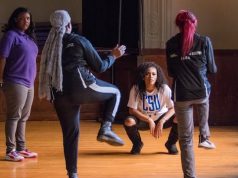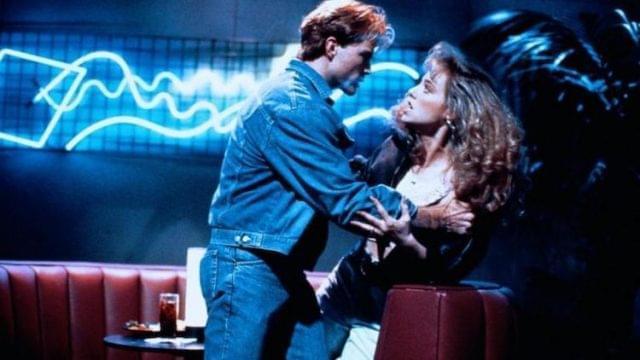
Do you remember where you were on March 16, 1990? Of course you do. That’s the day that two — yes, TWO — movies about a sexy dance called the lambada hit theaters, and you had to choose which of them to see first. Moviegoers were stymied. It was the “Sophie’s Choice” of awful movies about phony dance crazes!

One movie was simply called “Lambada.” The other film was supposed to be called “Lambada: The Forbidden Dance,” but the producers of the first “Lambada” had already registered the title with the MPAA, so the second “Lambada” had to drop that keyword from its name. It was thus released simply as “The Forbidden Dance,” with “…is Lambada!” added as a tagline, in case you weren’t sure which forbidden dance was being referred to.
Both movies were critical and box-office failures, but “The Forbidden Dance” seems to have been slightly worse, so that’s the one I watched. You might think it would be a brilliant idea to watch them both and compare them, and I agree that that’s a fine notion. You should definitely do that. Let me know how it turns out.
“The Forbidden Dance” stars Laura Harring, who had been Miss USA five years earlier. As you know, beauty-pageant contestants are best suited not for acting or dancing but for doing topless photos shoots and making poorly worded political statements. Vacant-headed but at least beautiful, Harring is paired with a fellow named Jeff James, who isn’t particularly good-looking, can’t really dance or act, and who in fact has no other onscreen film credits before or since this one. It’s as if he was conjured just for “The Forbidden Dance,” then sent back into oblivion whence he came, like a golem.
The film would have us believe that the lambada originated in the Amazonian rain forests of Brazil, where the native tribes spend their evening hours slithering around campfires and thrusting their hips at one another. As the film begins, one such tribe is doing exactly that when they are interrupted by trucks and bulldozers. It seems an American conglomerate called Petramco has bought the Indians’ land, with plans to relocate the natives, cut down all the trees, and build, I don’t know, probably a Brazilian-dance-themed nightclub.
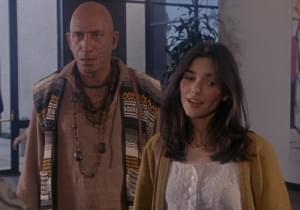
In order to save their land, the chief’s daughter, Nisa (Laura Harring), and the unspeaking tribal shaman, Joa (Sid Haig), go to Los Angeles to plead with Petramco’s CEO. They show up at company headquarters, where the security guard asks for their names. Nisa says, “Nisa,” and the guard asks for her surname, and she says she doesn’t have one. The guard should then ask, “Well, then how did you get a passport? And a plane ticket? We just saw stock footage of an airplane landing, which implied that this is how you arrived in the United States. Are you calling the filmmaker a liar? Did you actually sneak in through some other means? And if you did fly, how did you do that without a last name and some form of government-issued identification?” But the guard doesn’t ask any of those things, which makes me question his usefulness.

Instead, Joa the witch doctor works some freaky magic in the lobby, leading to his arrest (WHERE’S YOUR VOODOO NOW??), while Nisa escapes and spends the night sleeping next to a public fountain. In the morning, a maid named Carmen (Angela Moya) passes by on her way to the fancy mansion she works at, takes pity on Nisa, and helps her get a job at the same, or perhaps a different, fancy mansion. The wealthy white people Nisa now works for have a son, Jason (Jeff James), who spends all his nights dancing at trendy nightclubs. The very first night that Nisa is living at the mansion, Jason passes by her bedroom on his way out and sees her writhing around sexily (?) to music that only she can hear (there is no radio or cassette player in the room) — apparently, her Amazonian tribe is so committed to the lambada lifestyle that they dance even when there is no music to dance to or partner to dance with. In times of great emergency, a lacy curtain can be used as a partner.
Having seen just how sexy (?) and how well (?) Nisa dances, Jason invites her to join him at the club, where all his snobby rich friends make racist remarks that include pejorative terms referring to Mexicans, even though Nisa is clearly Brazilian. I mean, I don’t condone racism at all, but I especially don’t approve of it when it’s done sloppily. Let’s get our slurs straight, people.

Undaunted by the slapdash hate-mongering, Nisa takes Jason on the dance floor and shows him the lambada, aka the forbidden dance (…is lambada!). She explains: “Fifty years ago, the government of Brazil forbid it because it was too sexy.” That’s a hilariously dumb thing to say in a movie, of course, but I do like the idea of governments banning things for being too sexy. Especially Brazil! Too sexy for Brazil?! Don’t they spend about 51 weeks a year down there partying drunkenly in the streets for one festival or another? What does it take to be TOO SEXY??! And more to the point, how bad is Nisa at the lambada? Because when she does it, it hardly looks sexy at all, and certainly not sexy enough to warrant government intervention.
Jason’s parents are dismayed to learn their son has been out doing forbidden dancing with the hired help, and their mean comments hurt Nisa’s feelings, so she runs out into the night to find work at a sleazy strip club. (If you move to L.A. without knowing anyone there, you will inevitably wind up working at a sleazy strip club. Count on it.) It’s called Xtasy, and it’s one of those creepy places with upstairs rooms where the dancers have sex with the patrons. Hmm. Not so much a strip club as a brothel, I guess. The woman in charge of Xtasy, Mickey (Miranda Garrison), hires Nisa on the spot, then provides far too much unwanted assistance as Nisa changes into her costume. Mickey claims to be glad that Nisa, unlike many exotic dancers, actually has some talent for dancing, but this compliment rings hollow given the fact that she hasn’t seen Nisa dance yet. Unanswered is the question about whether Brazil’s strict anti-lambada laws carry any weight here, and whether Nisa can be extradited for unlawful sexiness while traveling abroad.

Jason arrives after a couple days to rescue Nisa from this harsh life, whereupon the two hatch a plan. Auditions are coming up for King Creole & the Coconuts, a Latin-fusion band that has a weekly TV show. If Nisa and Jason pass the audition, they’ll be on live television, which will be the perfect opportunity to hijack the show and plead their case against Petramco, because if there’s one thing viewers of a live music-and-dance TV program love, it’s strident political messages from foreigners.
Jason tries to get his rich parents to help out, but they refuse. His mom sums it up thus: “I do not want my son involved with an Indian princess from the jungle!” (And what mother does, really?) Also unhelpful is Jason’s snotty blond girlfriend, Ashley (Barbra Brighton), who is furious at being dumped for a jungle princess and aligns herself with Petramco to thwart Jason and Nisa’s plans. Petramco has a cowboy-hat-wearing hired goon named Maxwell (Richard Lynch), you see, and even though nobody at Petramco has seen Nisa since that day she showed up at headquarters, and even though Petramco has no idea what she and Jason are planning, she is still considered a thorn in the company’s side. I submit that Petramco’s side is easily thorned.
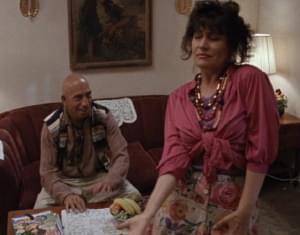
Oh, Joa the witch doctor got out of jail, by the way, and he, Jason, and Nisa are all living with Carmen the maid now, which leads to a dreadful parallel seduction montage where Jason and Nisa are getting it on in the bedroom while Carmen and Joa are out in the living room. No doubt Carmen is thrilled because she always wanted to land a doctor. Wait’ll she finds out Joa isn’t really a witch doctor but merely a witch physician’s assistant.
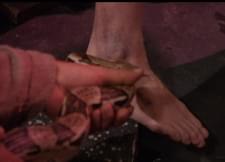
Anyway, to prevent the live TV appearance, Maxwell has Jason knocked unconscious and left in the hills while he abducts Nisa and takes her to an abandoned theater, which he apparently owns (what?), and where he forces her to dance for him (also what?). Jason arrives just in time to rescue Nisa and rush to the club where the live TV appearance is happening, though he twists his ankle in the process. Luckily, Joa shows up with Nisa’s father, the king of their tribe (in full Native American feathery regalia, and probably just as last-name-free as his daughter), and he has a snake with him, too. Why a snake? Because its bite will cure Jason’s twisted ankle so that he can dance on TV. Since Joa didn’t know until he arrived that Jason was injured, we’re forced to conclude that this snake’s bite is a cure-all, and that Joa simply carries one with him everywhere he goes. I would welcome further insight on this topic, if any witch doctors or witch medical students are reading this.

You know where it goes from here. They dance on TV; they make their statement against Petramco; everyone agrees to boycott the company; the day is saved. It ends with an onscreen declaration: “This film is dedicated to the preservation of the rain forest.” So to those of you who saw “Lambada” on March 16, 1990, instead of “The Forbidden Dance,” I hope you’re happy with your anti-rain-forest choice. WHY DO YOU HATE THE EARTH??
(For a genuinely fascinating story about family rivalries and ultra-cheap filmmaking, I recommend this article by Patrick Runkle. It explains why two lambada films came out on the same day: because they were produced by cousins who had formerly worked together to create a huge catalog of terrible films, then had a falling-out in the late 1980s and became fierce rivals. It is an epic Hollywood story about two astonishingly untalented artists.)
— Film.com


